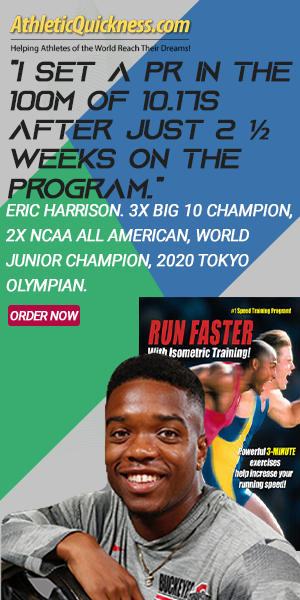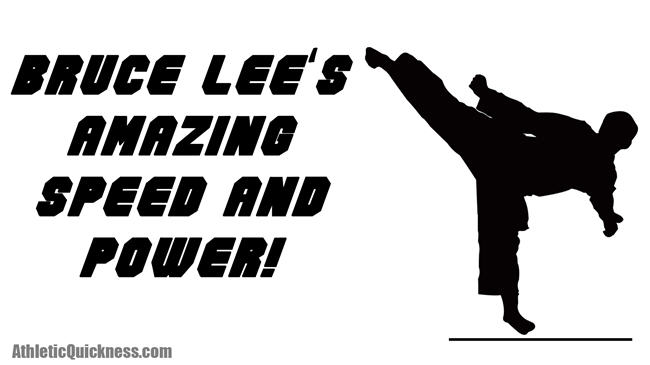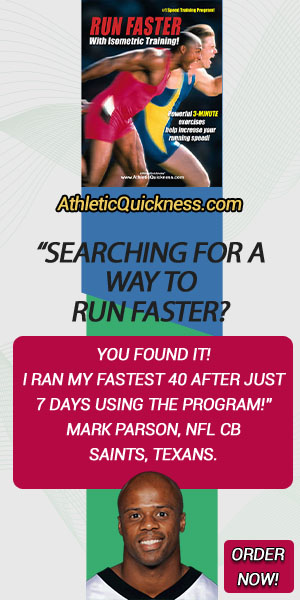Bruce Lee
“Pound-for-pound one of the fastest and quickest athletes the world has ever seen …..”
We received a couple of testimonials regarding Bruce Lee and the martial arts.
One was from Jaacob Bowden, a professional golfer with an event record of a 421 yard drive.
Jaacob wrote, “The martial artist Bruce Lee is known for being pound-for-pound one of the fastest and quickest athletes the world has ever seen. Through my research, I found out that isometrics were a big part of his training regimen. As I was looking for ways to increase my own golf swing speed, I decided to include isometrics in to my long drive training using the very same bands you can get here at AthleticQuickness.com. The results were phenomenal!
Using the bands to complement my other training techniques, I increased my maximum club head speed to 155 mph and hit an event-record 421-yard drive to win a qualifier for the Remax World Long Drive Championships. Consequently, we now advocate the use of isometrics training with resistance bands as a part of our overall swing speed training programs at Swing Man Golf. Isometrics with resistance bands for higher swing speeds and longer drives really do work!”
The other testimonial came from H. Ray ChoHoRyu – Karate Kobudo Federation, Puerto Rico. He wrote: “Hello, I been using your technique isometrics and resistance bands together 10 days now and my speed has improved about 18%. My whole body moves faster now, and I am much lighter. I just move faster now, and the routine is quick. I love it.
I still have a long way to go, because I am a martial arts expert, but I have to check what works and what doesn’ t work. This technique combining isometrics and the resistance band together is the secret to speed in any sport … PS. I am 50 years old and move like a 25 year old. You found the SECRET TO SPEED TRAINING … GREAT WORK.”
Until receiving these testimonials, I had no idea that Bruce Lee was such a big advocate of isometric training, although I am not all that surprised. I also hadn’t really thought much about its applications in the martial arts; and, this may be the subject for my next book.
But, the reason for this article is to reinforce the value of including an isometric training program into your existing training routine. Who better than Bruce Lee to help me convince you???
How did Bruce Lee get to be one of the best athletes in the world?
If you’ve watched any of Bruce’s movies, you have no doubt believing that he was someone with a very special talent. His lighting- quick moves and chiseled frame might have some people thinking that there was some sort of Hollywood special effects taking place. The things he was able to accomplish, physically, seem to defy nature. But the truth is, there were no special effects.
In Bruce’s case, it was a matter of devoting himself to being the best he could be. Few would argue that Bruce Lee was, and still is, considered to be, pound for pound, the best athlete in the world. But how did he get this way?
It would be easy for most of us say he was simply born that way, but from what I have been reading, Bruce Lee actually spent an enormous amount of his time reading about different workout routines, training strategies, diet etc. and then incorporating these ideas and concepts every waking minute. He evaluated the results of his training strategies, kept those that worked best and eliminated the rest.
He was incredibly devoted to his training, and his body showed this. He also had perhaps one of the lowest body fat percentages ever for an athlete, and he credits isometric training with helping him develop his lean muscle mass and become the person he was and the one that left a lasting impression on the rest of us. Isometrics was an important part of his daily training routine.
What were Bruce Lee’s isometric triaining routines like?
Bruce Lee was born in 1940 and died in 1973, when there were no such things as using resistance bands for isometric training or any athletic training for that matter. What was commonly used as an isometric tool were things like a towel or rope that were used to do pulling motions.
You would hold each end of the towel in a separate hand, hook the towel around your feet or a pole, and pull towards you for about 10 seconds.
Or, maybe you looped the towel around a bar above your head and pushed downwards to work your triceps. Sometimes you may have just pushed against a wall for several seconds. But more often than not, one’s own body weight supplied enough resistance along with muscles opposing other muscles in the body to create resistance.
From what I have been able to research, Bruce’s isometric routine consisted of just a few exercises. Each of these exercises was held for between 6-12 seconds. Lee strongly felt that each session should be approached with nothing less than 100% intensity, although we now know that 60-70% effort will get the job done, thus reducing your chance of injury.
Some of these exercises were a press-lockout, press-start, toe-raise, pull, parallel squat, and shoulder shrug. I am not sure exactly how they were done; but, just by the names, it would be reasonable to think that he was simply using his own body weight for resistance.
One of his favorite exercises was isometric training for punching power. It was one of his favorites, because it built power and speed at different ranges.
To do this exercise, he used a rope or karate belt. He held the belt in both hands and assumed a fighting stance, placed his left hand behind his back, wrapped the other end around his shoulder and threw a short range punch with his right hand.
He held it for 6-12 seconds then extended his punch to ¾ distance, held for another 6-12 seconds, then extended his punch all the way and held for 6-12 seconds. He became famous for his lightening punches and his legendary ‘one inch punch’.
Bruce Lee’s power was in his tendons as well as his muscles.
Most of Bruce’s power (speed and strength) was tendon power, not muscle size, and was developed through stationary (i.e. isometric) “motion”.
With a body weight of around 135 pounds, it is reasonable to assume that his speed and strength did not come from large muscles. In fact, his superior power (speed and strength) was very disproportionate for someone his size. The isometric power that Bruce had is what is known as sinewy power, which means strong-like tendons.
Tendons are the connective tissue that attach muscles to bone, and they play a very big part in your muscle speed and strength. Muscles grow in size when you lift weights, but tendons grow when muscles meet resistance but don’t’ move, i.e., isometric training.
This is why bodybuilders, who take steroids to pump up their muscles, often rupture tendons by doing simple activities such as climbing stairs, because while the size of their muscles grew, the strength in their tendons did not, leaving them weak in proportion to the activity being performed and resulting in injury.
Tendons are often compared to acting like strong rubber bands for your arms and legs; and, therein lies a very important clue as to how to develop the blazing speed, quickness and power that Bruce Lee possessed.
Could Bruce Lee have done even better with isometrics and today’s resistance bands?
Here’s what we know so far: We know that Bruce Lee was heavy into isometric training. We know he developed lean muscle mass and athletic quickness by using this strategy. We know that while weight training develops big muscles, isometric training develops both muscles and tendons.
We also know that tendons, as well as muscles, are very similar to rubber bands, as far as their actions are concerned. (What happens when you stretch a rubber band and release one end? It contracts with amazing speed!)
But, here is what we know or have and perhaps Bruce Lee didn’t know or have: We have, by far, a better isometric training tool that we can use to shape and quicken our muscles. We have the resistance band, a far superior training device, when it comes to increasing muscle speed, than a towel, rope or belt.
The resistance band, unlike a static rope, belt or towel, actually gives back elastic speed into the muscles and tendons when using it with an isometric training strategy.
All of the training programs on our website are based on this principle. Bruce Lee knew the value of isometric training. One can only imagine how much more he could have accomplished if he would have had rubber bands to train with. (Maybe he did and just didn’t tell anybody.)
Always glad to help!
Dr. Larry Van Such






